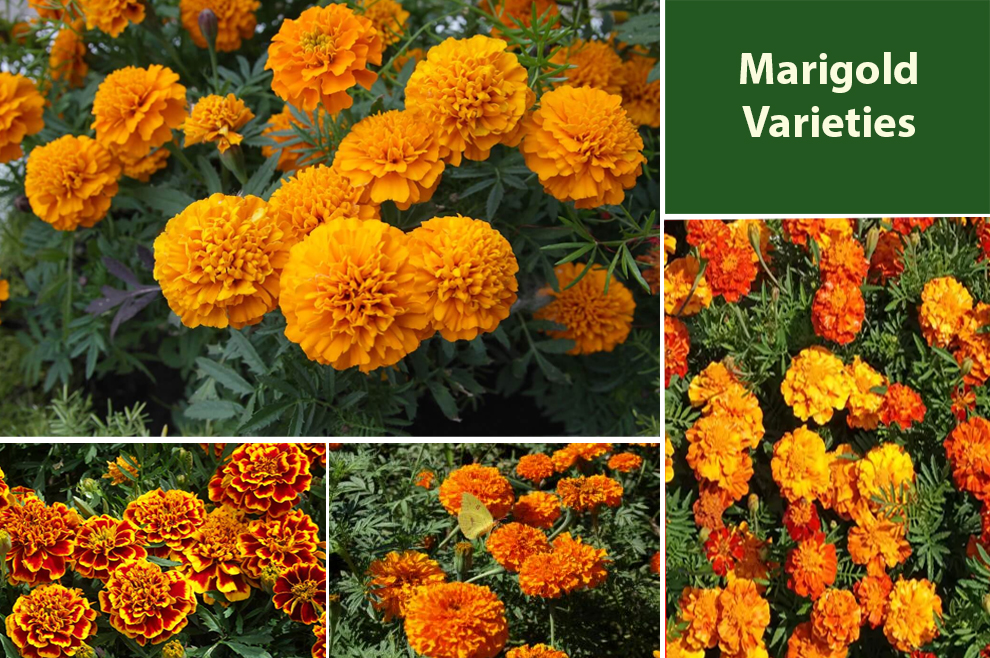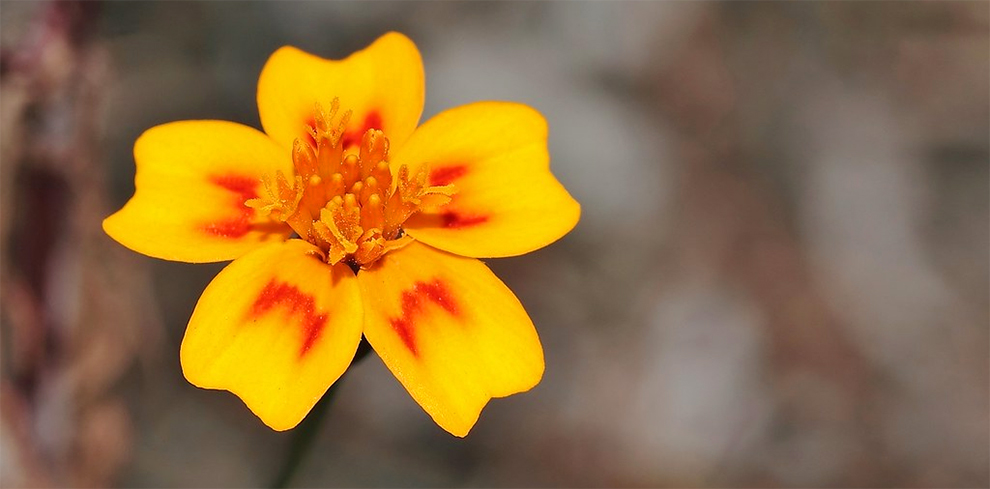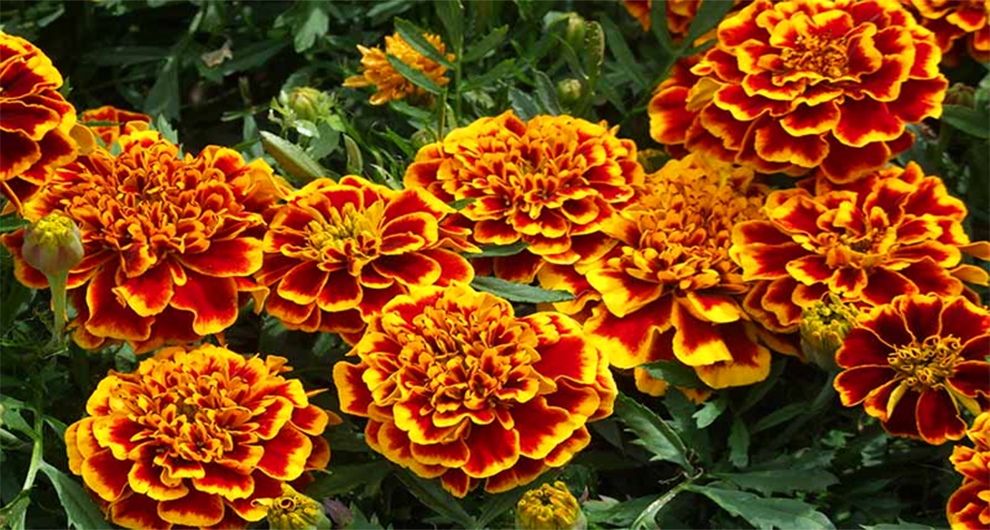Different Marigold Flower Varieties
Marigolds come in many sizes like tall, short & with large flowers. It is impossible to name them all. But we will tell you about the most popular ones that include African, French, Signet, Triploid Marigolds, and a few more.

Marigolds are a diverse group of flowering plants that belong to the genus Tagetes. The number of marigold types may vary depending on different classification systems and regional variations.
However, here are some of the commonly recognized types of marigolds:
These are just a few of the common types of marigolds, and within each type, there are numerous cultivars and varieties available, each with its unique characteristics and traits.
Gardeners can choose from a wide range of marigold varieties to suit their preferences and create stunning displays of color in their gardens.
| Scientific name | Tagetes spp. |
| Species | Tagetes erecta (African Marigold), Tagetes patula (French Marigold), Tagetes tenuifolia (Signet Marigold), and other species within the Tagetes genus. |
| Plant family | Asteraceae (Compositae) |
| Flower colors | They come in shades of yellow, orange, gold, red, and bi-color combinations. Some varieties may also have white or cream-colored flowers. |
| Bloom time | From spring to fall |
| Care | Marigolds are easy to care |
| Height & spread | African marigolds can grow up to 3 feet in height with a spread of about 1 to 2 feet (30 to 60 cm). French marigolds are shorter, ranging from 6 to 18 inches in height and spread. Signet marigolds are typically more compact, reaching heights of around 6 to 12 inches with a similar spread. |
| Lifespan | Marigolds are annual or short-lived perennial plants. |
Different Types Of Marigolds
Below we enlist the main types of marigolds. Since, Marigolds come in various sizes and colors, in the later sections we categorize them on the basis of that as well.
Here let us look at the primary types of marigolds:
A. African marigold varieties
These marigolds also known as Tagetes erecta are popular for their tall stature, large flower heads, and robust blooms.
They come in a range of colors, including shades of yellow, orange, and gold. Examples include ‘Crackerjack’ and ‘Inca.’
B. French marigold
French marigolds or Tagetes patula are more compact compared to different varieties of marigolds.
They produce smaller flowers and have a wider range of colors, including shades of red, orange, and bicolor combinations.
Examples include ‘Disco Mix’ and ‘Bonanza.’
C. Signet marigold
Tagetes tenuifolia also known as Signet marigolds are characterized by their small, dainty flowers and finely divided foliage. They often have a spreading habit and are ideal for edging or container gardening.
Examples include ‘Lemon Gem’ and ‘Tangerine Gem.’
D. Triploid marigolds
Triploid marigolds are hybrid marigolds resulting from crossing African and French marigolds. They combine the larger flower size of African marigolds with the wider color range of French marigolds.
Examples include ‘Jubilee’ and ‘Super Hero Marigold.’
E. Pot marigold
Pot marigold, also known as Calendula officinalis, is a distinct type of marigold that is popularly grown for its ornamental and medicinal properties.
It is different from the common marigold (Tagetes species) mentioned earlier.
Pot marigold has bright, daisy-like flowers that come in various shades of yellow and orange.
It is often cultivated in pots, containers, or garden beds, and its petals are sometimes used for culinary purposes or in skincare products for their soothing and healing properties.
F. Southern Cone Marigold
Tagetes minuta, commonly known as Southern Cone Marigold is a species of marigold native to South America. These are different kinds of marigolds that are distinct from the commonly cultivated marigold plant varieties.
These are primarily grown for their unique aromatic properties and their potential use as a natural insect repellent. Tagetes minuta is a tall and bushy plant, reaching heights of 3 to 6 feet.
It features fern-like foliage and small yellow or orange flowers. The leaves and flowers emit a strong and pungent scent, which is believed to help deter pests and insects in the garden.
Due to its natural repellent properties, it is sometimes planted near crops to help protect them from pests.
G. Red-crescent Marigold

Red-crescent marigold or Tagetes lunulate is a species of marigold that is native to Mexico and Central America.
Among the different types of marigolds, this one is a smaller and more compact marigold compared to other varieties.
Tagetes lunulata is characterized by its distinctive bi-colored flowers, which have a dark orange or reddish-brown center surrounded by bright yellow or gold outer petals.
The flowers bloom profusely and are attractive to pollinators. These plants have a bushy growth habit and reach a height of around 1 to 2 feet.
They are often grown as annuals and are popular for borders, containers, and bedding displays, adding vibrant colors and a touch of exotic flair to garden landscapes.
New Marigold Varieties

Marigold breeders and seed companies are constantly working on developing new varieties with improved traits.
Newer varieties have unique colors, compact growth habits, increased disease resistance, and extended bloom periods.
Some of the new varieties include Arka Shubha, Pusa Bahar, Arka Pari, Pusa Basanti, Arka Bangara, and Pusa Narangi.
Marigold Hybrid Varieties
Marigold hybrid varieties are created through controlled cross-pollination of different marigold species or cultivars.
These different kinds of marigolds are developed to exhibit the best traits of two different species.
Here are a few examples of marigold hybrid varieties:
- ‘Marvel II’
- ‘Jedi Series’
- ‘Bonanza Series’
- ‘Taishan Yellow’
- ‘Fireball’
These are just a few examples of the many hybrid marigolds available. Hybridization allows breeders to introduce new and exciting traits, expanding the range of colors, sizes, and growth habits in marigolds.
Different Types of Marigold Flowers Based On Size
Marigold flowers come in various sizes, ranging from small to large. Here are some common types of marigold flowers based on their size:
A. Large marigold variety
One of the notable large marigold types is Tagetes erecta ‘American Giant’ or simply ‘Giant Marigold’.
As the name suggests, this cultivar is known for its impressive size, with plants reaching heights of 3 to 4 feet and sometimes even taller.
The flowers of ‘Giant Marigold’ are substantial, typically measuring around 3 to 4 inches in diameter.
They come in vibrant shades of yellow, orange, and gold, creating a bold and eye-catching display in gardens or as cut flowers.
B. Short marigold varieties
Short marigolds offer a charming and compact option for smaller gardens, containers, or edging.
Tagetes patula ‘Nugget’ is a popular dwarf French marigold that stands at a height of 6 to 10 inches and produces small, single flowers in various colors.
Another delightful choice is Tagetes tenuifolia ‘Lemon Gem,’ a signet marigold that reaches up to 12 inches tall.
It features delicate, fern-like foliage and small, edible yellow flowers with a pleasant citrus fragrance. With their petite stature and vibrant blooms, these varieties bring beauty and color to limited spaces.
C. Tall marigold varieties
Tall marigolds offer an impressive presence in the garden with their towering heights and large, vibrant blooms.
A popular tall variety of marigolds is Tagetes erecta ‘Crackerjack,’ known for its robust growth that can reach 2 to 3 feet in height.
Its fully double flowers in shades of yellow, orange, and gold create a stunning display.
Another standout is Tagetes erecta ‘Giant Yellow,’ which lives up to its name by growing up to 3 feet tall and showcasing striking, fully double yellow flowers.
With their commanding stature and bold colors, tall marigolds bring a touch of grandeur to flower beds, borders, and cut flower arrangements.
Related: How to Plant Marigold Seeds | Best Marigold Fertilizers
Different Varieties Of Marigolds Flower Information and FAQs
A. What are the best-tasting marigolds that are edible?
When it comes to edible marigolds, the most popular and commonly used variety is Tagetes tenuifolia, commonly known as signet marigold or gem marigold.
Signet marigolds have a pleasant citrusy, fruity flavor, and their flowers and leaves are often used as a garnish or in salads. They add a pop of color and a subtle tangy taste to dishes.
It’s important to note that not all marigolds are edible, so if you’re specifically looking to use marigolds in cooking or salads, make sure you choose a variety that is explicitly labeled as edible, such as Tagetes tenuifolia.
Additionally, always ensure that the marigolds you use for consumption have not been treated with pesticides or other chemicals that may be harmful when ingested.
B. Are there any white marigold varieties?
White marigold flowers are quite rare and not commonly found. Marigolds typically come in shades of yellow, orange, and red. However, there have been some efforts in plant breeding to develop white or cream-colored marigold cultivars.
Some rare creamy white marigold flowers include French Vanilla, African Kilimanjaro, Snowball, and Moonstruck.
C. Which type of marigolds are perennials?
The majority of marigold flowers are annuals, which means they complete their life cycle within one year. However, there are a few perennial marigold species as well.
The most common perennial marigold is Tagetes erecta, also known as the African marigold or Mexican marigold. While most marigolds are annuals, Tagetes erecta can sometimes act as a short-lived perennial in warmer climates.
It’s worth noting that even perennial marigolds may not live indefinitely. They may have a lifespan of a few years before eventually declining or succumbing to adverse conditions.
In general, marigolds are known for their ability to self-seed, meaning that even annual marigolds can reappear in the same area the following year if allowed to go to seed.
D. Which marigold has the strongest smell?
Among marigold varieties, the one with the strongest smell is typically Tagetes lucida, commonly known as Mexican tarragon or Mexican marigold.
It is known for its anise-like fragrance, which can be quite potent. Tagetes lucida is often used as a culinary herb and has a strong aroma that is reminiscent of licorice or tarragon.
It’s important to note that the strength of the smell can vary between individuals, and personal perceptions of fragrance can also differ.
If you’re interested in experiencing the strong smell of marigolds, particularly the anise-like scent, Tagetes lucida would be a good choice to explore.
E. Which marigolds are best for pest control?
Marigolds are often valued for their pest-repellent properties, as certain varieties can help deter pests from vegetable gardens and other plants.
The two main species of marigold flower that are commonly used for pest control are Tagetes patula (French marigold) and Tagetes erecta (African marigold).
These marigolds produce strong scents that repel various insects, including aphids, nematodes, and whiteflies.
French marigolds (Tagetes patula) are particularly effective at repelling nematodes, small soil-dwelling pests that can damage the roots of plants.
African marigolds (Tagetes erecta) have a strong aroma that helps deter a wider range of pests, including aphids and whiteflies.
